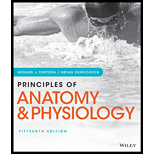
Principles of Anatomy and Physiology
15th Edition
ISBN: 9781119329398
Author: Gerard J Tortora, Bryan Derrickson
Publisher: John Wiley & Sons Inc
expand_more
expand_more
format_list_bulleted
Concept explainers
Question
Chapter 14, Problem 22CP
Summary Introduction
To review:
The diagnostic value of an EEG (electroencephalogram).
Introduction:
EEG is the graphical representation of brain waves, which are generated by the neurons that are close to the cerebral cortex. These graphical representations play a major role in diagnosing various disorders.
Expert Solution & Answer
Want to see the full answer?
Check out a sample textbook solution
Students have asked these similar questions
In a small summary write down:
Not part of a graded assignment, from a past midterm
Noggin mutation: The mouse, one of the phenotypic consequences of Noggin mutationis mispatterning of the spinal cord, in the posterior region of the mouse embryo, suchthat in the hindlimb region the more ventral fates are lost, and the dorsal Pax3 domain isexpanded. (this experiment is not in the lectures).a. Hypothesis for why: What would be your hypothesis for why the ventral fatesare lost and dorsal fates expanded? Include in your answer the words notochord,BMP, SHH and either (or both of) surface ectoderm or lateral plate mesoderm
Chapter 14 Solutions
Principles of Anatomy and Physiology
Ch. 14 - Compare the sizes and locations of the cerebrum...Ch. 14 - Prob. 2CPCh. 14 - Prob. 3CPCh. 14 - Prob. 4CPCh. 14 - Prob. 5CPCh. 14 - 6. Where are the medulla, pons, and midbrain...Ch. 14 - Prob. 7CPCh. 14 - Prob. 8CPCh. 14 - Describe the location and principal parts of the...Ch. 14 - 10. Where do the axons of each of the three pairs...
Ch. 14 - Prob. 11CPCh. 14 - Prob. 12CPCh. 14 - Prob. 13CPCh. 14 - Define a circumventricular organ.Ch. 14 - 15. List and locate the lobes of the cerebrum. How...Ch. 14 - Prob. 16CPCh. 14 - Prob. 17CPCh. 14 - Prob. 18CPCh. 14 - Prob. 19CPCh. 14 - Prob. 20CPCh. 14 - Prob. 21CPCh. 14 - Prob. 22CPCh. 14 - How are cranial nerves named and numbered?Ch. 14 - Prob. 24CPCh. 14 - Prob. 25CPCh. 14 - Prob. 26CPCh. 14 - Prob. 27CPCh. 14 - Prob. 28CPCh. 14 - Prob. 29CPCh. 14 - Prob. 30CPCh. 14 - Prob. 31CPCh. 14 - Prob. 32CPCh. 14 - Prob. 33CPCh. 14 - 34. Where do the motor axons of the accessory (XI)...Ch. 14 - Prob. 35CPCh. 14 - Prob. 36CPCh. 14 - Prob. 37CPCh. 14 - An elderly relative suffered a CVA (stroke) and...Ch. 14 - Prob. 2CTQCh. 14 - 3. You have been hired by a pharmaceutical company...
Knowledge Booster
Learn more about
Need a deep-dive on the concept behind this application? Look no further. Learn more about this topic, biology and related others by exploring similar questions and additional content below.Similar questions
- What does the heavy dark line along collecting duct tell us about water reabsorption in this individual at this time? What does the heavy dark line along collecting duct tell us about ADH secretion in this individual at this time?arrow_forwardBiology grade 10 study guidearrow_forwardI would like to see a professional answer to this so I can compare it with my own and identify any points I may have missedarrow_forward
arrow_back_ios
SEE MORE QUESTIONS
arrow_forward_ios
Recommended textbooks for you
 Principles Of Radiographic Imaging: An Art And A ...Health & NutritionISBN:9781337711067Author:Richard R. Carlton, Arlene M. Adler, Vesna BalacPublisher:Cengage Learning
Principles Of Radiographic Imaging: An Art And A ...Health & NutritionISBN:9781337711067Author:Richard R. Carlton, Arlene M. Adler, Vesna BalacPublisher:Cengage Learning Human Physiology: From Cells to Systems (MindTap ...BiologyISBN:9781285866932Author:Lauralee SherwoodPublisher:Cengage Learning
Human Physiology: From Cells to Systems (MindTap ...BiologyISBN:9781285866932Author:Lauralee SherwoodPublisher:Cengage Learning- Surgical Tech For Surgical Tech Pos CareHealth & NutritionISBN:9781337648868Author:AssociationPublisher:Cengage
 Fundamentals of Sectional Anatomy: An Imaging App...BiologyISBN:9781133960867Author:Denise L. LazoPublisher:Cengage Learning
Fundamentals of Sectional Anatomy: An Imaging App...BiologyISBN:9781133960867Author:Denise L. LazoPublisher:Cengage Learning


Principles Of Radiographic Imaging: An Art And A ...
Health & Nutrition
ISBN:9781337711067
Author:Richard R. Carlton, Arlene M. Adler, Vesna Balac
Publisher:Cengage Learning

Human Physiology: From Cells to Systems (MindTap ...
Biology
ISBN:9781285866932
Author:Lauralee Sherwood
Publisher:Cengage Learning

Surgical Tech For Surgical Tech Pos Care
Health & Nutrition
ISBN:9781337648868
Author:Association
Publisher:Cengage

Fundamentals of Sectional Anatomy: An Imaging App...
Biology
ISBN:9781133960867
Author:Denise L. Lazo
Publisher:Cengage Learning
